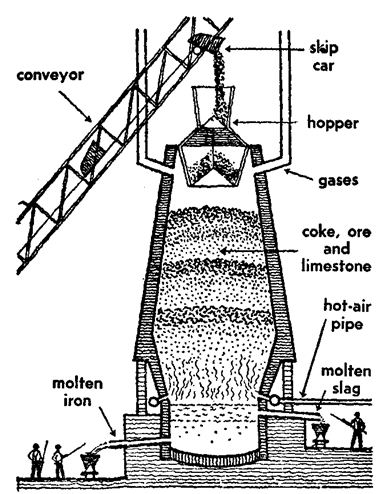Process:
Iron oxide is added up to the blast furnace in the form of raw ore, sinter or pellets. The raw ore is eliminated from the earth and sized into pieces that range from 0.5 to 1.5 inches. This ore is either Magnetite (Fe3O4) or Hematite (Fe2O3) and the iron content ranges from 50% to 70%. This iron rich ore may be directly charged into a blast furnace without any additional processing. Iron ore that contains a lower iron content should be processed or beneficiated to enhance its iron content. Pellets are generated from this lower iron content ore. This ore is ground & crushed into a powder so that the waste material known as gangue can be eliminated. The remaining iron-rich powder is rolled up into balls and fired in a furnace to generated strong, marble-sized pellets that have 60% to 65% iron. Sinter is generated from fine raw ore, sand-sized limestone, small coke, and many other steel plant waste materials that have some iron. These fine materials are proportioned to attain desired product chemistry while mixed together. Then this raw material mix is placed on a sintering strand that is similar to a steel conveyor belt, where this is ignited by gas fired furnace and fused from the heat from the finer coke into bigger size pieces that are in the range 0.5 to 2.0 inches. The iron ore, sinter and pellets then become the liquid iron generator in the blast furnace along any of their remaining impurities going to the liquid slag.

Figure: Blast Furnace
The coke is generated from a mixture of coals. The coal is crushed & ground in a powder and then charged up into an oven. Like the oven is heated up the coal is cooked up so most of the volatile matter such like oil & tar are eliminated. The cooked coal, known as coke, is eliminated from the oven after 18 to 24 hours of reaction time. The coke is cooled up and screened into pieces ranging through one inch to four inches. The coke has 90 to 93% carbon, some ash and sulphur however compared to raw coal this is very strong. The strong pieces of coke along a high energy value provide permeability to heat & gases that are required to drop off and melt the iron ore, sinter and pellets.